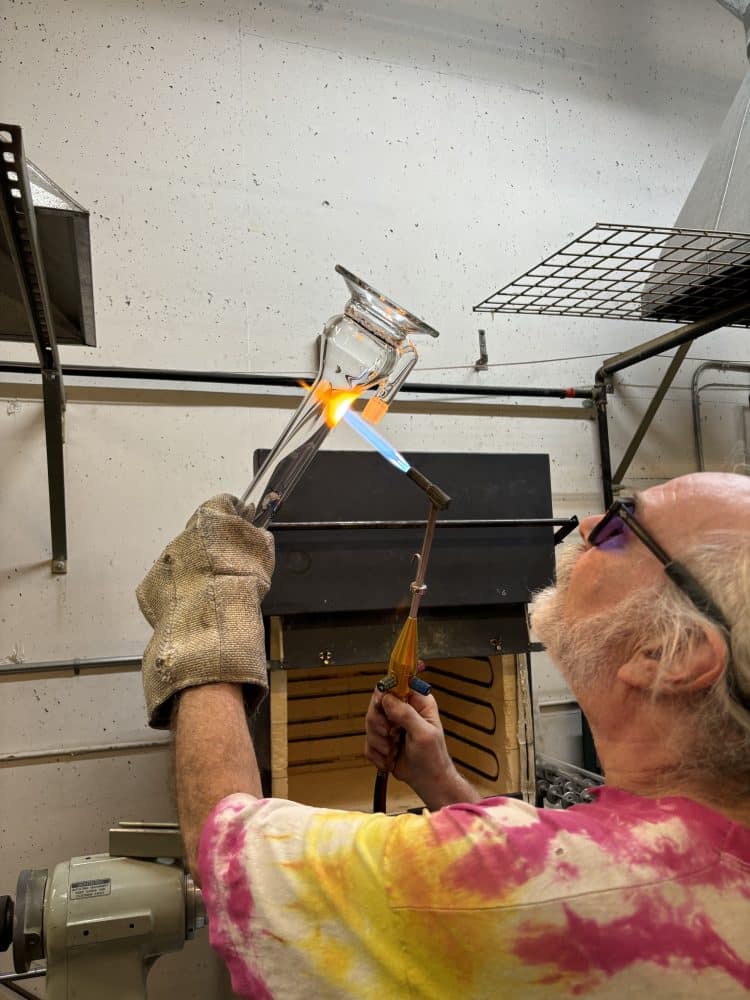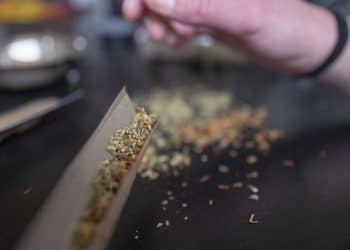When it comes to smoking devices, the method of smoke filtration can play a crucial role in the overall experience and perceived smoothness of each hit. Among the various smoking tools available, bongs stand out for their unique filtration capabilities. Unlike traditional pipes or other devices, bongs are designed with water chambers that may effectively filter and cool the smoke before inhalation.
This filtration process begins as smoke passes through the water, which acts as a natural filter, trapping heavier particles and water-soluble molecules. As a result, the smoke that reaches the user is often cooler and smoother compared to direct inhalation from a pipe. This cooling effect can reduce the harshness of the smoke, making it more enjoyable for users.
Compared to other smoking devices like joints or blunts, bongs can provide a cleaner and potentially harm mitigated smoking/vaping experience by filtering out some of the harmful substances present in smoke. This aspect makes them a preferred choice for many smokers who prioritize smoother hits and reduced irritation to the throat and lungs.
We will discuss this topic with Mr. David Goldstein, one of the most prolific designers in the history of glass smoking accessories, inventor of the Rooster apparatus and founder of the Precision Glassware inc. Dave gained extensive experience with laboratory glassware during his tenure at the University of Maryland’s technical glass shop in 1980.
He understood that for chemists aiming to cleanse gases with liquids, the preferred apparatus was a gas washing bottle equipped with a fritted disc. Mr. Goldstein embarked on a mission to develop a coarse fritted disc capable of functioning at lung pressure, a type not commercially available. In his experimentation, he found that adapting laboratory equipment to function as a water pipe yielded better results than trying to make a water pipe resemble laboratory apparatus.
1. Is smoking cannabis through a bong considered one of the safest methods of consumption?
We can’t make any claims regarding the safety of cannabis consumption. We may surmise that inhaling the gaseous effluent from smoking or vaporizing cannabis will always be more stressful to the body than edibles, though achieving optimal dosage with edibles presents its own set of considerable challenges. In 1963, Surgeon General Luther Terry suggested that water filtration might help mitigate noxious compounds in tobacco smoke. The National Institutes of Health (NIH) never followed up with any in depth research on the topic, but the testing done in support of our patent rather strongly suggests that this is the case, at least for our products.
2. Can you please explain how “Henry’s law” ensures that the cannabis smoke will be “cleaner”?
There is a set of equations known as “Henry’s law”, describing the transfer of soluble materials in a gas to a liquid as a function of the pressure against the bubble at its’ point of formation. The smaller the bubble, the greater force exerted against the liquid, and that “partial pressure” interface is where chemical transfer takes place, if the bubble is small enough so the pressure is high enough.
3. You came out with an inimitable fritted disc in your bongs. How can this water-pipe component ameliorate the quality of the smoke reaching the lungs?
The novelty of Rooster’s fritted disc is that it was developed to work at a lower pressure differential than fritted discs used in laboratories. In laboratory settings, fritted discs are connected to vacuum pumps, which are stronger than our lungs and can generate enough pressure differential/suction to generate the really tiny bubbles that are desirable for laboratory practice. The pores in a rooster disc are much bigger than laboratory-use discs, but they are still apparently small enough to provide some measurable removal of unwanted substances.
Increasing the pore size and area for easy draught for average lungs also makes the disc easily cleaned. Some people cannot grasp that Rooster bubbles start out so small that cold water will condense payload and taste, and clog the disc with it. When cold water is coupled with poor portion control, I am usually blamed for the dabber’s bad technique.
People who make dabs are the perfect influencers to inform people, with authority, that filtration is preferable to condensation, and that single serving dabs, with warm water are virtuous, especially at lower dab temperatures. Head shops don’t spread the truth about this (or Roosters). I appreciate every educated person inclined to speak the truth about this because there is so much dogma to dispel.
4. Do water pipes reduce the cannabinoid content in the smoke that reaches the lungs?
We did our testing with tobacco, so can’t answer that to the letter, but I think we can infer some probabilities common to burning cellulose in both cases.
Tetrahydrocannabinol (THC) is not water soluble, so it’s not going to show up in bong water unless it is condensed out by contact with cold water or cold glass. We did remove some polycyclic aromatic hydrocarbons (PAHs) from the tobacco smoke. It’s possible these originated from burning cellulose and similar results could be expected with cannabis.
5. You conducted experiments comparing three different smoking devices based on their performance, safety, and filtering properties. We found the analysis of the smoke bubbled through water particularly interesting, especially regarding the presence of carcinogenic compounds known to be present in tobacco smoke. Could you please elaborate on this analysis?
Well, again, I am constrained that I cannot make any health claims, but this is a good place to point out that the cited prior art, typical of what’s found in contemporary head shops, showed almost no harm mitigation through water filtration, The significant reductions of particulates and PAH is unique to Roosters.
The Patent & Trademark office asked me to prove that my design had some novelty over prior art.
In this case, much to my delight, they asked me to show how the Rooster was an improvement over the Odyssey Glass Toker 2, which was patented by my old boss/mentor/friend, Roger Graham.
The Toker 2 was an excellent choice for prior art, as the 20 square millimeter opening defined by its 5mm inside diameter stem is so equivalent to the diffusive openings found in most head shop bongs.
One aspect of the testing that seems to indicate greatly superior efficacy of the fritted disc is the turbidity result. After 3 g of tobacco burned, the roosters had about 10x the particulate absorption of the Toker 2. Eventually, particulate absorption dropped off, indicating saturation of the water, and necessity of regular water changes to keep the apparatus at top performance. The Roosters collected the same or more particulate from 2 grams of tobacco than the Toker 2 did from 10 grams.
UV analysis was performed to measure suspension of PAHs in the used water, and revealed that the roosters removed 145-190% more PAHs from 10 grams of tobacco smoke than the Toker 2. This translated to the standard mesh rooster removing 6% of the PAHs from the smoke effluent, while the larger surface area/ finer mesh disc removed 10%.
Additionally, the results of the filter paper analysis showed that the used rooster water had a higher concentration of particulates in the water than the air, which was not the case with the Toker 2, and strong evidence that the Roosters were suspending particulates in the water.
These testing results were recognized by the Patent and Trademark office as a “novel and unexpected result,” which I’m told is their highest compliment.
6. Do you recommend smoking anymore? Have vaporizers evolved to deliver desired dosage and taste without combustion?
That’s a heavy question! I think everybody, as an individual, has to answer that question for themselves. My personal habit, old geezer that I am, is to take a lot of small dabs with an electric nail set at 610 °F. When on the road, I have a Puffco “Proxy” rig, also used at 610°F. My friends all like the Proxy rig better than my plug-in rig because It doesn’t have a junkie vibe. The vaporizer works on a 45 second timer, encouraging users to inhale for either 22 or 15 seconds, encouraging the user to make efficient use of lung capacity. This vaporizer, in my opinion, works better than any terp slurper.
Recent technology for vaping plants is comparably good to recent technology for vaping concentrates. I’ve been using a 14mm cartridge system for vaping plant, a Finnish gizmo called Tiny Mite. It works quite well. Not burning the cellulose in plant achieves the same practical end as eliminating it by extraction. I made a prototype fritted disc accessory for it that works really well, and looks pretty cool. I can see that coming out in the not too distant future.
I don’t think people need to smoke anymore, but many will for a long time, and given them harm associated with that practice, Roosters merit their consideration.
7. Some people consider dabbing the way to get the maximum out from cannabis and extraction derivatives, while avoiding combustion-byproducts from flaming cellulose. What do you think about this?
The popular practice of slapping a carb cap on an oversized dab and taking a bunch of increasingly played out hits is poor technique. Sadly, an entire industry of dysfunctional glass/quartz ware has grown up around it. I suspect that the unnaturally high dosage of terpenes and thiols in the first pull off a half-gram dab will eventually cause the sort of solvent damage techs doing extractions wear solvent respirators to avoid. I think this will become evident in 30 years. In the meantime, I recommend 20-30 dabs/gram. That’s been my dosage regimen since 2012 and I can still ride my bike and hit the gym as a senior citizen.
The best practice for dabbing from laboratory perspective, is to size your dab appropriately to your lung capacity, so that you inhale the lion’s share of a dab in one inspiration. This leaves only a tiny amount of reclaim, which the most conscientious dabbers will remove with a cotton swab. The particulate residue left over from evaporated dabs is a taste killer. Swift removal is a good practice.
Once the dab is vaporized, and starts its route to lungs and brain, the best practice is to filter it with a fritted disc and warm water, which will discourage condensation of flavor and payload while removing particulates and PAHs. Inhaling the dab to the full extent of one’s lung capacity also gives the payload time and lung exposure to migrate from the lungs to the brain.
I have watched innumerable videos of influencers using “terp slurps” with a variety of spinning toys and caps. Invariably, they load grossly oversized dabs , and blow the green hit out after about 4 seconds because they’ve used up all their lung capacity spinning toys around. They then proceed to take 3-4 hits of reclaim, after blowing out about ten hits of terpenes and thiols out after the first few seconds.
Taking oversized dabs causes fractional distillation. This results in unnatural concentration of temps and thiols in the first hit, and complete deficit in subsequent hits. Taking oversized dabs and immediately blowing out the best part is kind of an insult to the oil, which is best appreciated a single serving.
8. The market for cannabis concentrates, including those used for dabbing, has expanded with advancements in extraction technologies and consumer demand for more potent products. What are the risks associated with this?
Cannabis has proven itself remarkably non-toxic over thousands of years of cultivation and use. There’s some statistical suggestion that daily cannabis use is now eclipsing daily alcohol use. I think that as intoxicant market share is taken from alcohol and tobacco, the overall social result is positive. I think that edibles are probably the most potentially problematic segment of the cannabis extract industry. I probably don’t know a single stoner who hasn’t passed out on a brownie once, myself included. That is potentially a problem both with driving and parenting.
I think that consumer demand for more exotic cannabis extracts is going to come at the expense of demand for high end liquor, and will ultimately result in minor, but widespread harm reduction.
With regards to dabbing specifically, I think there are a couple cautionary notes. I’ve read that it’s become common practice in extraction labs now to wear solvent respirators around evaporating terpenes. When dabbers with bad technique throw a half a gram or more into whatever quartz they use, they’re doing a fractional distillation, and that first hit has an order of magnitude more terps and thiols than the second hit that follows a few seconds later. I am personally a little suspicious that such practice might be too much of a good thing, and perhaps being harmful in the long term, while effective (though inefficient) in the short term.
9. With the increasing popularity of cannabis concentrates, how do you see the evolution of dabbing devices like slurpers and quartz bangers impacting the market for traditional bongs?
I think that the whole culture of heady glass had its’ swan song with quarantine, and has been in contraction since we reopened. I don’t think it has anything to do with changing product lines in head shops. I think the whole culture of head shops and heady glass isn’t translating to a culture of young stoners who are buying cannabis from the dispensary instead of the plug. Dispensaries commonly offer some Chinese accessories, bongs, pipes, vaporizers that offer pretty good value. Going to the head shop is less fun than going to the dispensary, and patronizing head shops isn’t a high priority for younger stoners. Pardon the pun.
10. When considering recommendations for future generations regarding cannabis consumption, what would you suggest?
Wow, that is a really great question, thank you for asking!
- First of all “Emancipate yourself from mental slavery.”
Get educated! Learn basic math, science, and critical thinking. Recognize that corporatization of cannabis came along with legalization, and that corporatization isn’t always a good thing. Cannabis is good for thinking outside the box, which is where you see the big picture. Retire the stereotype of the dumb stoner. - Vape
- Grow your own plants, if your state allows it.
- Grow outdoors if possible.
- Learn how to roll a joint. Smoke one occasionally.
- Learn and honor the history and culture of cannabis. A lot of people made some pretty big sacrifices to get us where we are. We stand on their shoulders and owe them their place in history.


















